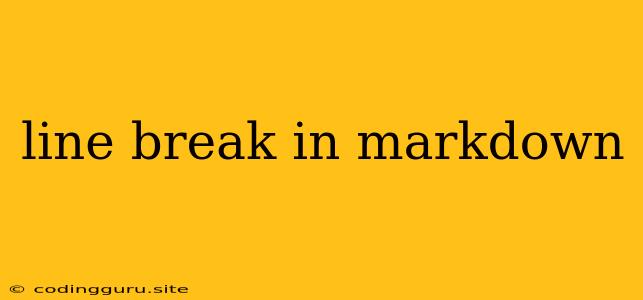Line Breaks in Markdown: Mastering the Art of Formatting Your Text
Markdown, the lightweight markup language, is a popular choice for writing content online. It's easy to learn and use, making it ideal for bloggers, developers, and anyone who needs to create readable and structured text. However, one question that often arises is how to properly create line breaks in Markdown.
In this article, we'll delve into the intricacies of line breaks in Markdown, exploring the different methods available and when to use each one. We'll also provide practical examples to help you grasp the concepts easily.
Understanding the Basics
Markdown is designed to be simple and intuitive. It relies on a minimal set of symbols to create formatting elements. When it comes to line breaks, Markdown deviates slightly from the traditional way of handling them. In HTML, the <br> tag is used to create a line break. However, Markdown takes a different approach.
The Two Methods for Line Breaks
1. Hard Line Breaks
To create a hard line break in Markdown, simply add two or more spaces at the end of a line followed by a newline character (Enter key). This will force a line break, creating a new line directly below the previous one.
Example:
This is the first line.
This is the second line.
Output:
This is the first line. This is the second line.
2. Soft Line Breaks
Soft line breaks, on the other hand, are less explicit. They rely on the Markdown processor to decide where to wrap lines based on the available space. By default, a single newline character will not create a line break. Instead, it will be interpreted as a single space.
Example:
This is the first line.
This is the second line.
Output:
This is the first line. This is the second line.
When to Use Hard Line Breaks
Hard line breaks are best suited for situations where you want to control the exact layout of your text. For example, you might use them to:
- Create a blank line: A hard line break will create a visible space between two paragraphs.
- Separate short lines: When you have a list of short items, hard line breaks can improve readability.
- Control the spacing in tables: If you're using Markdown for tables, hard line breaks can be used to align elements within cells.
When to Use Soft Line Breaks
Soft line breaks are generally preferred for natural text flow. They allow the Markdown processor to optimize line wrapping for different screen sizes and devices. Use soft line breaks for:
- Normal paragraphs: When writing regular text, rely on the Markdown processor to handle line breaks.
- Code blocks: Soft line breaks are ideal for displaying code snippets.
Line Breaks in Markdown: Best Practices
- Consistency is key: Choose a line break method and stick to it throughout your document.
- Readability: Ensure your line breaks enhance readability, not hinder it.
- Markdown processor variations: Keep in mind that different Markdown processors may handle line breaks differently. Test your code in various platforms to ensure consistent rendering.
Example of Line Breaks in Markdown
Let's look at a practical example of how line breaks in Markdown can be used to create a visually appealing document.
This is a paragraph of text. It is formatted using soft line breaks, allowing the text to flow naturally across different screen sizes.
Here is a list of items:
* Item one
* Item two
* Item three
This is another paragraph.
This line is intentionally broken using a hard line break.
This is the end of the document.
Output:
This is a paragraph of text. It is formatted using soft line breaks, allowing the text to flow naturally across different screen sizes.
Here is a list of items:
- Item one
- Item two
- Item three
This is another paragraph.
This line is intentionally broken using a hard line break.
This is the end of the document.
Conclusion
Line breaks in Markdown are an essential part of creating readable and visually appealing content. By understanding the difference between hard and soft line breaks, and when to use each method, you can effectively control the layout and flow of your text. Remember, consistency and readability should be your guiding principles.
